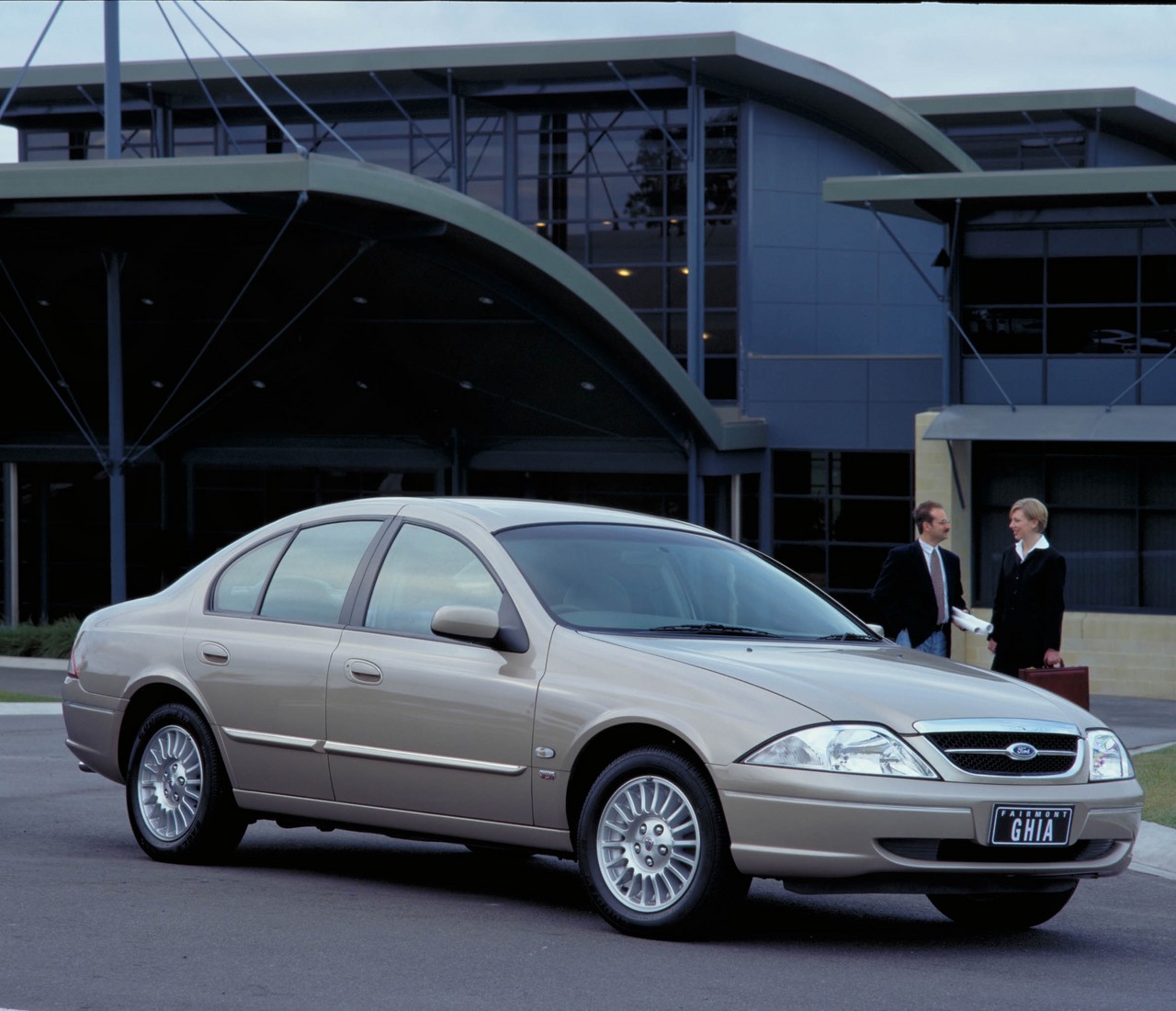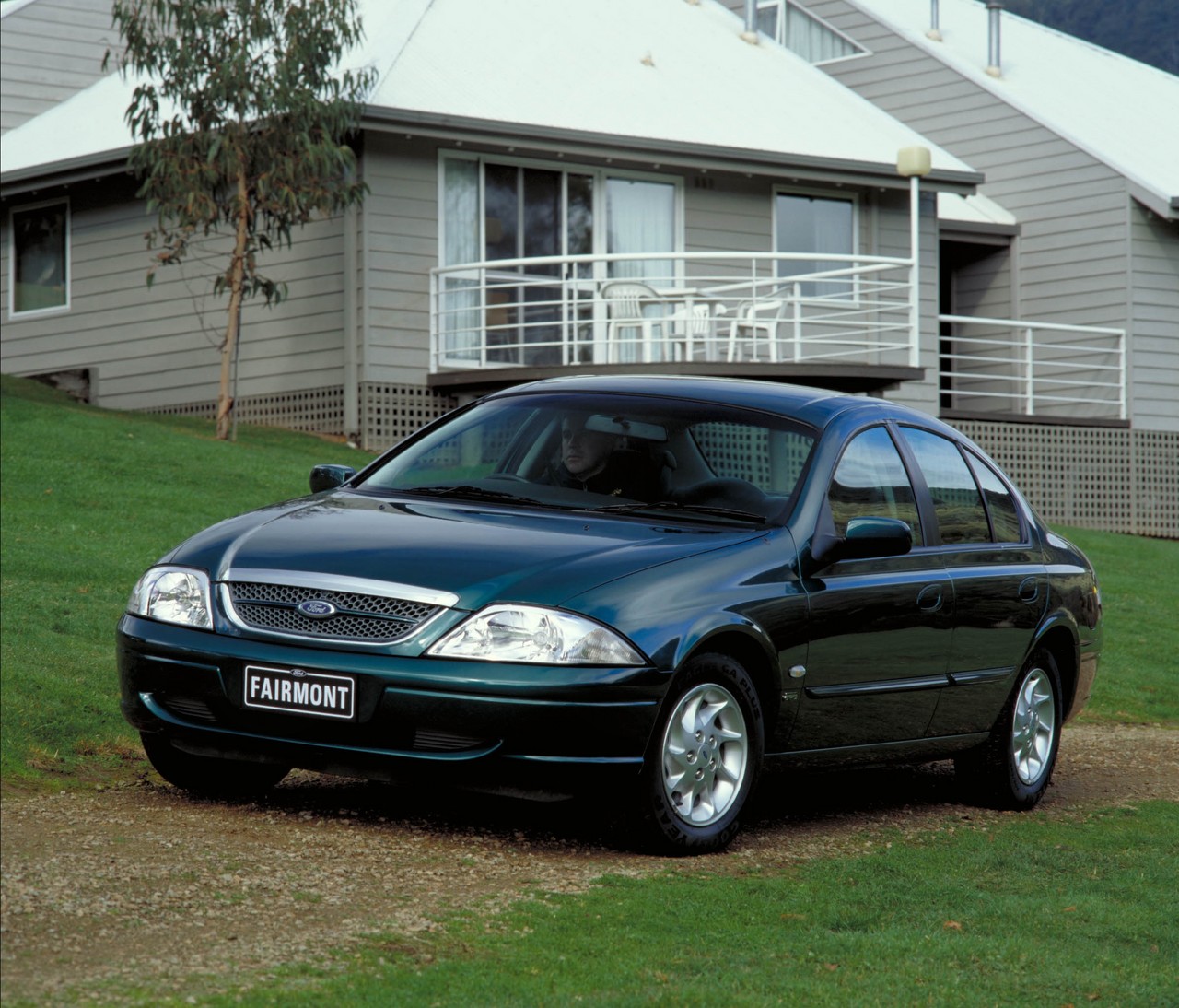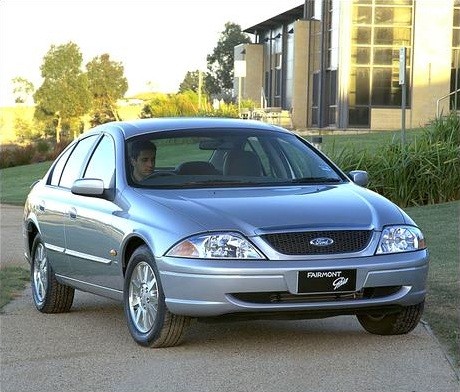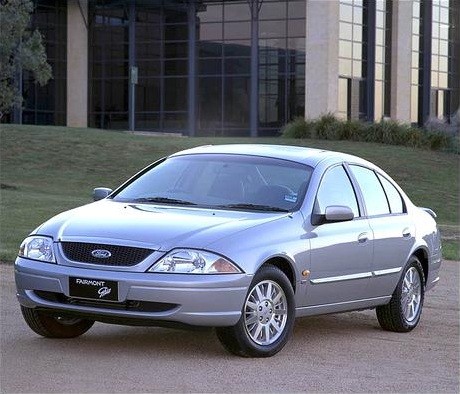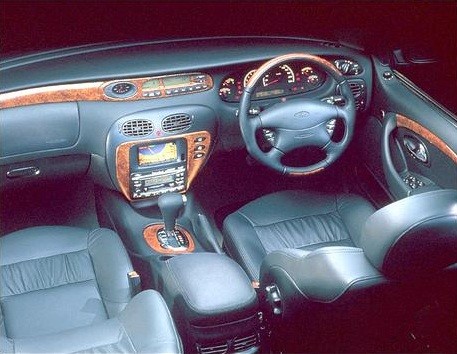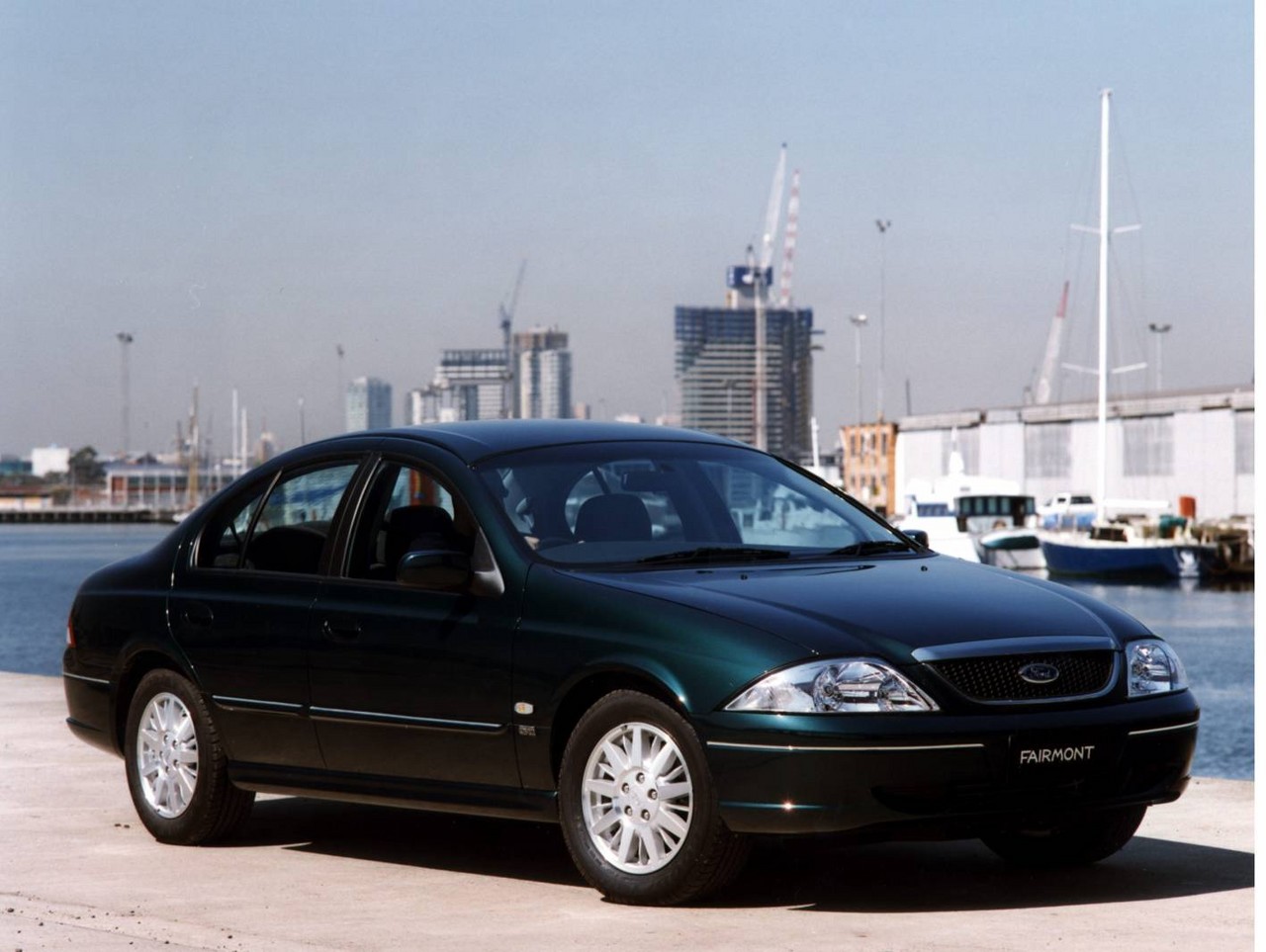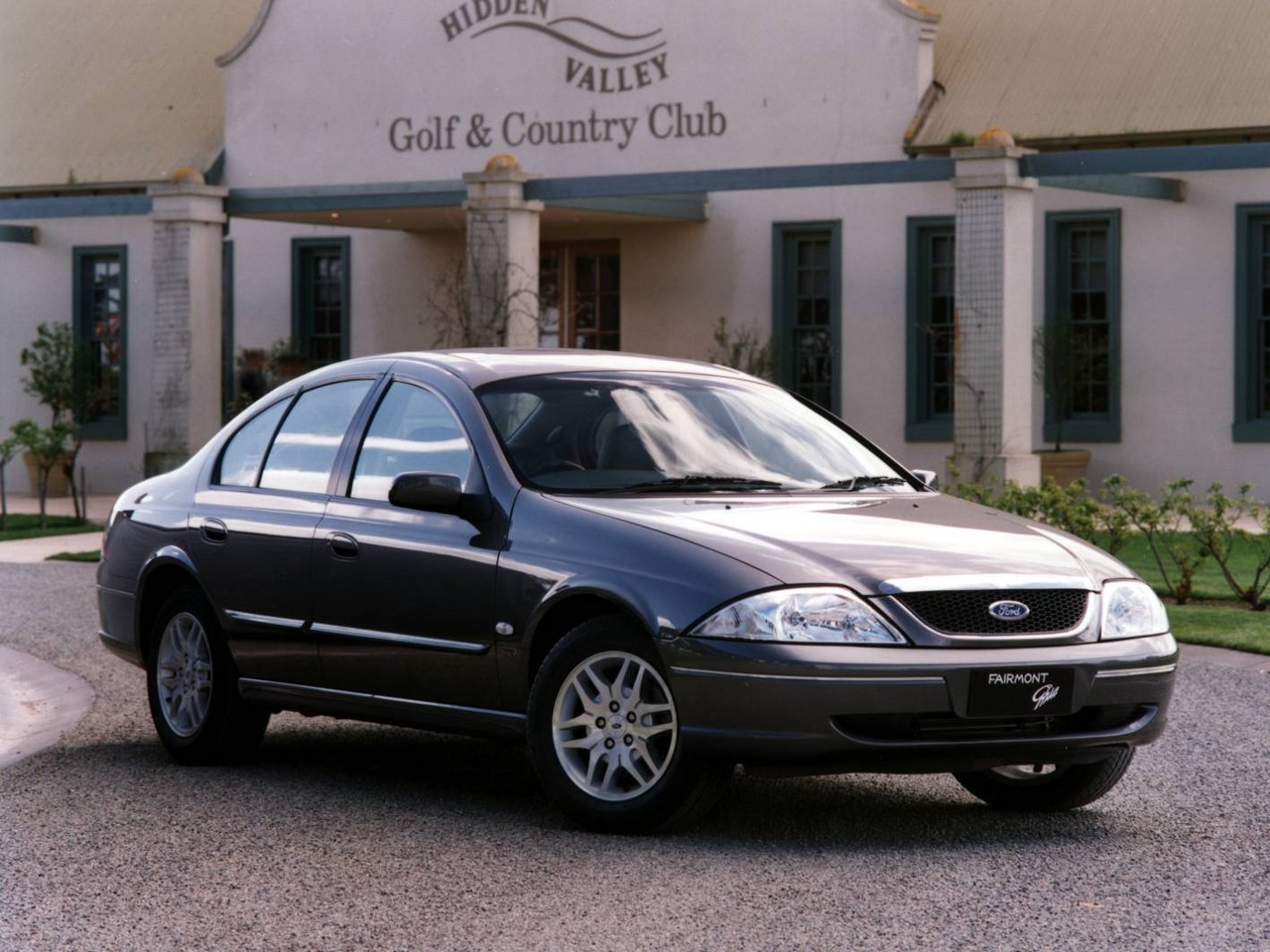
- Responsive 4.0-litre inline six-cylinder engine
- For AU.II and AU.III Fairmont, comfortable ride
- Comfortable and supportive front seats
- Folding rear seats and large boot for cargo
- Accurate steering
- Basic live rear axle for standard Fairmont
- For AU.I Fairmont, suspension lacks compliance while cabin lacks sound insulation
- Awkward rear seat entry and exit
- Dull interior
Review: Ford AU.I Fairmont (1998-00)
Overview
Released in September 1998, the Ford AU Series I (AU.I) Fairmont range was available as a large sedan or wagon. Manufactured in Campbellfield, Victoria, the rear-wheel drive Ford AU.I Fairmont and Fairmont Ghia were available with 4.0-litre inline six cylinder and 4.9-litre V8 unit petrol engines.
Engines: Intech, Intech VCT, LPG and V8
Of the engines,
- The 4.0-litre Intech six cylinder petrol engine had cast iron block, an alloy cylinder head, sequential electronic fuel injection, a single overhead camshaft (SOHC, chain-driven), two valves per cylinder, an EEC V control unit and a compression ratio of 9.65:1. Compared to its predecessors, the Intech engine had a more rigid block, a new cylinder head, triple-layered steel head gasket, more rigid crankshaft with larger bearings, lighter Teflon-coated pistons, lighter connecting rods, single conical valve springs, a cast aluminium sump (cross-bolted through the main bearing caps), electronic distributorless ignition system (EDIS) and a ‘limp home’ mode which enabled the engine to keep running without coolant fluid. Furthermore, a flexible decoupler between the exhaust manifold and new catalytic converter enabled a lower idle speed of 550 rpm;
- For the Fairmont Ghia, the Intech VCT engine added variable cam timing (VCT) and a low back pressure exhaust system. The VCT system used different camshaft profiles to increase torque from 1000-3700 rpm and power beyond 3700 rpm. The VCT module was mounted on the front of the engine and adjusted camshaft timing via an oil pressure-driven helix;
- As an option, the Fairmont was available with a dual fuel (i.e. LPG/petrol) system which used had Vialle liquid-to-gas converter, venturi gas/air mixer in the intake tract and used the EEC V control module to manage both the LPG and petrol systems. When starting, the petrol/LPG mix would depend on conditions and, once started, the engine would run solely on LPG. The dual fuel system weighed 85 kg and dual fuel models therefore had modified suspension. For sedan models, the tank was fitted under the rear window shelf, while wagon models had a toroidal tank under the rear floor; and,
- The 4.9-litre pushrod Windsor V8 engine had a cast iron block and cylinder head, two valves per cylinder, EEC V engine management and a compression ratio of 9.1:1. For the AU range, the V8 engines were based on a later generation small block developed for the Ford UT Explorer. Compared to its predecessor, this V8 engine had GT40P cylinder heads with centralised platinum spark plugs, a ‘high flow’ fuel intake system, new inlet manifold and distributorless ignition.
Transmissions
The AU Fairmont was available with four-speed BTR M93LE and M97LE automatic transmissions for the six and eight cylinder models, respectively. For the AU range, the automatic transmissions were upgraded with:
- A multi-groove C1 (clutch #1) plate friction elements for smoother gear engagements; and,
- A ‘variable pressure solenoid’ which improved shift quality.
Development and dimensions
Developed in conjunction with the AU Falcon at a cost of $700 million, the AU Fairmont had a new body structure with straightened side rails that were welded together to a beam behind the front bumper. The AU Fairmont was around 35 kg lighter than its predecessor, in part due to its 4 kg lighter body structure and 8 kg lighter bake-hardened steel panels. Despite these mass reductions, body lateral bending rigidity increased 20 per cent, longitudinal bending rigidity was up 17.5 per cent and torsional rigidity increased by 13.8 per cent.
Other innovations for the AU Falcon and Fairmont included new headlights for a 30 per cent increase in light projection, triple weather-strip sealing for the doors (previously double weather-strips) and new sound proofing materials – sourced from OrbSeal Australia – which expanded during the paint baking process to fill gaps and cavities more effectively.
Compared to its EL Fairmont predecessor, the AU Fairmont sedan was 11 mm shorter (at 4907 mm), 9 mm wider (1870 mm), 20 mm taller (1481 mm) and had a 2 mm longer wheelbase (2793 mm). Compared to the sedans, the wagons were 151 mm longer (at 5058 mm), 49 mm taller (1530 mm) and the wheelbase was extended by 129 mm (2922 mm). The AU Fairmont sedan and wagon had drag coefficients of 0.295 and 0.341 Cd, respectively.
Relative to the AU Falcon , the Fairmont could be identified by the raised centre section of its bonnet, more prominent grille with chrome edge capping and unique headlights with chrome bezels and clear side indicator lenses. The standard Fairmont had a chrome front hood moulding with a body-coloured centre bar and grille mesh; the Fairmont Ghia, however, was distinguished by its bright silver bumper inserts, black mesh grille and chrome centre bar.
Suspension
The Ford AU Fairmont introduced double-wishbone front suspension as standard for all models, while three different rear suspensions were offered:
- The standard Fairmont sedans had a live rear axle with unequal length upper and lower longitudinal arms, an anti-roll bar and Watts links pivoting off the differential housing to side rail brackets;
- The Fairmont wagon had ‘Wide Trac’ rear suspension which differed in that the shock absorbers were located outboard of the leaf springs and angled towards the front of the car; and,
- The Fairmont Ghia had multi-link, double wishbone independent rear suspension that had adjustable toe links and was isolated via a rear subframe.
| Body | Engine | Trans. | Peak power | Peak torque | |
|---|---|---|---|---|---|
| Fairmont | Sedan, wagon |
4.0-litre Intech petrol I6 | 4sp auto | 157 kW at 4900 rpm | 357 Nm at 3000 rpm |
| 4.9-litre Windsor petrol V8 | 4sp auto | 175 kW at 4600 rpm | 395 Nm at 3200 rpm | ||
| Fairmont Ghia | Sedan | 4.0-litre Intech VCT petrol I6 | 4sp auto | 168 kW at 5300 rpm | 370 Nm at 3500 rpm |
| 4.9-litre Windsor petrol V8 | 4sp auto | 175 kW at 4600 rpm | 395 Nm at 3200 rpm |
Safety equipment
Standard safety equipment for the Ford AU.I Fairmont included a driver’s airbag and ABS, while the Fairmont Ghia was further equipped with a front passenger airbag and traction control. From May 1999, the Fairmont was fitted with a front passenger airbag as standard.
Brakes
The AU.I Fairmont had 287 mm by 24 mm vented front brake discs and 287 mm by 10.5 mm solid rear discs.
Features: Fairmont and Fairmont Ghia
Standard features for the Ford AU Fairmont included 15-inch alloy wheels, a six speaker sound system with a 100 watt amplifier and CD player, climate control air conditioning, woven velour seats, remote central locking, power mirrors and windows, power antenna, rake and reach steering wheel adjustment, trip computer and immobiliser. For wagon models, an optional third row of seats was available with separate backrest and capable of being folded forward.
Relative to the AU Falcon, the AU Fairmont was fitted with a higher instrument panel with wood paneling, an analog clock and redesigned display.
The Ford AU Fairmont Ghia was further equipped with 16-inch 18-spoke alloy wheels with a bright finish, an eleven speaker 250 watt stereo with six-disc CD player and speed dependent volume control and heavily patterned velour seats with a strip of leather and leather bolsters. Full leather trim – in graphite grey and charcoal – was available as an option and combined with a power adjustable driver’s seat.
Review: Ford AU.II Fairmont (2000-01)
Overview
Released in April 2000, the AU Series II (AU.II) Fairmont introduced structural upgrades, greater refinement and revised suspension (see ‘Developments’, below). Visually, the AU.II Fairmont could be identified by its squarer rear bumper, horizontal grille, larger wheels and tyres, improved cabin trim and rear number plate valance.
Developments
The AU.II Fairmont introduced the following developments:
- Upgraded brakes: thicker front and rear discs (see ‘Brakes’, below), twin-piston aluminium-headed front calipers, bigger non-asbestos brake pads, changes to the master cylinder and a higher capacity booster;
- Structural upgrades to enhance offset front and side impact performance, including a laminated impact protection panel in the driver’s floor area for improved lower leg protection;
- For greater refinement, a laminated firewall and the introduction of 16-inch wheels with 60-series tyres;
- Suspension changes:
- For the front suspension, the front anti-roll bar was revised and reduced-friction ball joints were introduced;
- For the rear suspension, a new shock absorber design with improved low speed tunability and reduction friction was introduced;
- For models with independent rear suspension, changes were made to spring rates, jounce bumpers and shock absorbers for greater ride comfort. The rear top suspension mount was also adjusted and a rear anti-roll bar was fitted as standard; and,
- Service intervals were also extended from 10,000 km to 15,000 km.
| Body | Engine | Trans. | Peak power | Peak torque | |
|---|---|---|---|---|---|
| Fairmont | Sedan, wagon |
4.0-litre Intech petrol I6 | 4sp auto | 157 kW at 4900 rpm | 357 Nm at 3000 rpm |
| 4.9-litre Windsor petrol V8 | 4sp auto | 175 kW at 4600 rpm | 395 Nm at 3200 rpm | ||
| Fairmont Ghia | Sedan | 4.0-litre Intech VCT petrol I6 | 4sp auto | 168 kW at 5300 rpm | 370 Nm at 3500 rpm |
| 4.9-litre Windsor petrol V8 | 4sp auto | 175 kW at 4600 rpm | 395 Nm at 3200 rpm |
Safety equipment
Safety equipment for the AU.II Fairmont was improved and consisted of dual front airbags, traction control and front seatbelts with pretensioners and load limiters made standard across the range; wagons were also fitted with a three-point lap-sash rear centre seatbelt, with the retractor integrated into the seat back.
Brakes
The AU.II Fairmont had 287 mm by 28 mm front brake discs with twin-piston calipers and 287 mm by 16 mm solid rear discs.
ANCAP crash testing
In ANCAP crash testing , the related AU.II Falcon received a three star adult occupant protection rating with a score of 24.2. In the offset crash test, there was a low risk of injury to all body regions, including the driver’s foot and lower leg due to excessive brake pedal movement.
Features
For the AU.II Fairmont, standard features were extended to include 16-inch alloy wheels (with 60-series tyres), six-stack CD player and speed alert with steering wheel controls.
The Fairmont Ghia was further equipped with a six-way power adjustable driver’s seat, while a Carin satellite navigation system was available as an extra-cost option.
2000 Fairmont Ghia 75th Anniversary edition
In November 2000, a limited run 75th Anniversary edition Fairmont Ghia was released, featuring 17-inch ‘Elegance’ alloy wheels, leather seats, a wood/leather Momo steering wheel, floor mats and alarm system. Visually, the 75th Anniversary edition was also distinguished by its side skirts and rear spoiler.
Review: Ford AU.III Fairmont (2001-02)
Overview
Released in October 2001, the AU Series III (AU.III) Fairmont introduced improved equipment levels and a minor cosmetic update. Visually, the AU.III Fairmont could be identified by its smoked headlight surrounds, the side skirts, clear side indicator lenses and darker tinted dot matrix windscreen (for reduced sun glare). The standard Fairmont was also fitted with body-coloured door mirrors.
| Body | Engine | Trans. | Peak power | Peak torque | |
|---|---|---|---|---|---|
| Fairmont | Sedan, wagon |
4.0-litre Intech petrol I6 | 4sp auto | 157 kW at 4900 rpm | 357 Nm at 3000 rpm |
| 4.9-litre Windsor petrol V8 | 4sp auto | 175 kW at 4600 rpm | 395 Nm at 3200 rpm | ||
| Fairmont Ghia | Sedan | 4.0-litre Intech VCT petrol I6 | 4sp auto | 168 kW at 5300 rpm | 370 Nm at 3500 rpm |
| 4.9-litre Windsor petrol V8 | 4sp auto | 175 kW at 4600 rpm | 395 Nm at 3200 rpm |
Features
As part of the update, the AU.III Fairmont was fitted with a six-way power adjustable driver’s seat. The AU.III Fairmont Ghia featured full leather seats, a ten-way power adjustable driver’s seat and driver’s seat and mirror memory functions.
Related links
